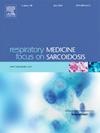呼吸困难相关的运动恐惧症是囊性纤维化的障碍:儿童和父母的作用
IF 3.1
3区 医学
Q2 CARDIAC & CARDIOVASCULAR SYSTEMS
引用次数: 0
摘要
由于疾病进展和感染风险,患有囊性纤维化(CF)的儿童可能缺乏运动,父母有时会过度保护。本研究旨在探讨儿童及其父母呼吸困难相关运动恐惧症与儿童呼吸肌力量、身体活动、健康和生活质量的关系。方法CF患儿43例(女21例,男22例,11.02±3.24岁)及其照顾者(母亲34例,父亲8例,表兄1例,39.45±6.76岁)。儿童进行肺活量测定、呼吸肌力量测试(最大吸气压力- mip、最大呼气压力- mep)、儿童体育活动问卷(PAQ-C)、慕尼黑体能测试(MFT)、屏气信念问卷(BBQ)、囊性纤维化问卷修订(CFQ-R)。家长完成了屏息信念问卷-照顾者版本(BBQ-C),疾病进展恐惧问卷(FoP), cfq - r -照顾者版本。采用Pearson相关系数进行分析。结果CF患儿的平均BBQ评分为28.62±10.76。BBQ与MIP%、MEP、MEP%和CFQ-R量表相关(p < 0.05)。家长的平均BBQ-C评分为28.06±9.85。BBQ-C与PAQ-C、MFT、FoP、CFQ-R量表相关(p < 0.05)。结论CF患儿及其父母存在较高的呼吸困难相关运动恐惧症。在儿童中,它与下呼吸肌力量和生活质量下降有关,而父母呼吸困难相关的运动恐惧症与孩子的身体活动、健康和生活质量更密切相关。父母与呼吸困难相关的运动恐惧症可能比儿童与呼吸困难相关的运动恐惧症与儿童的功能能力关系更密切,这突出了CF康复中处理社会心理因素的潜在价值。本文章由计算机程序翻译,如有差异,请以英文原文为准。
Dyspnea-related kinesiophobia as a barrier on cystic fibrosis: The role of children and parents
Background
Children with cystic fibrosis (CF) may be physically inactive due to disease progression and infection risk, with parents sometimes being overly protective. This study aimed to explore the relationship between dyspnea-related kinesiophobia in children and their parents and the child's respiratory muscle strength, physical activity, fitness, and quality of life.
Methods
Fourty-three children with CF (21 females, 22 males, 11.02 ± 3.24 years) and their caregivers (34 mothers, eight fathers, one cousin; 39.45 ± 6.76 years) included. Children underwent spirometry, respiratory muscle strength tests (maximal inspiratory pressure-MIP, maximal expiratory pressure-MEP), the Pediatric Physical Activity Questionnaire (PAQ-C), Munich Physical Fitness Test (MFT), Breathless Beliefs Questionnaire (BBQ), Cystic Fibrosis Questionnaire-Revised (CFQ-R). Parents completed the Breathless Beliefs Questionnaire-Caregiver Version (BBQ-C), Fear of Disease Progression Questionnaire (FoP), CFQ-R-Caregiver Version. Pearson's correlation coefficient was used for analysis.
Results
The mean BBQ score of children with CF was 28.62 ± 10.76. The BBQ was correlated with MIP%, MEP, MEP%, and CFQ-R subscales (p < 0.05). The mean BBQ-C score for parents was 28.06 ± 9.85. The BBQ-C was correlated with PAQ-C, MFT, FoP, and CFQ-R subscales (p < 0.05).
Conclusions
Children with CF and their parents show high levels of dyspnea-related kinesiophobia. In children, it was associated with lower respiratory muscle strength and reduced quality of life, while parental dyspnea-related kinesiophobia was more strongly associated with the child's physical activity, fitness, quality of life. Parental dyspnea-related kinesiophobia may be more closely related to the child's functional abilities than the child's dyspnea-related kinesiophobia, highlighting the potential value of addressing psychosocial factors in CF rehabilitation.
求助全文
通过发布文献求助,成功后即可免费获取论文全文。
去求助
来源期刊

Respiratory medicine
医学-呼吸系统
CiteScore
7.50
自引率
0.00%
发文量
199
审稿时长
38 days
期刊介绍:
Respiratory Medicine is an internationally-renowned journal devoted to the rapid publication of clinically-relevant respiratory medicine research. It combines cutting-edge original research with state-of-the-art reviews dealing with all aspects of respiratory diseases and therapeutic interventions. Topics include adult and paediatric medicine, epidemiology, immunology and cell biology, physiology, occupational disorders, and the role of allergens and pollutants.
Respiratory Medicine is increasingly the journal of choice for publication of phased trial work, commenting on effectiveness, dosage and methods of action.
 求助内容:
求助内容: 应助结果提醒方式:
应助结果提醒方式:


